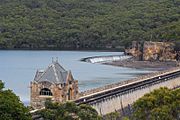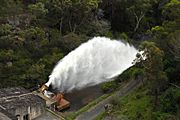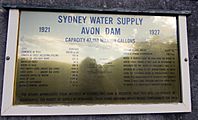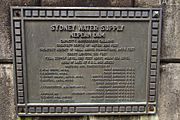Upper Nepean Scheme facts for kids
The Upper Nepean Scheme is a big system of dams and weirs in New South Wales, Australia. It collects water from four rivers: the Cataract, Cordeaux, Avon, and Nepean. This scheme includes four dams, two weirs, and a special canal system. This system uses gravity to move water into a large storage reservoir. It provides drinking water to many areas, including Macarthur, Illawarra, the Wollondilly Shire, and the big city of Sydney. The four dams and their related structures are important historical sites in New South Wales.
Contents
History of the Water Scheme
By 1867, the city of Sydney was growing fast. It needed more water than the old Botany Swamps could provide. So, the Governor, Sir John Young, asked a special group to find a new water source.
In 1869, this group suggested the Upper Nepean Scheme. This plan included weirs on the Cataract and Nepean rivers. It also planned for a large storage reservoir at Prospect. Plus, there would be about 102 kilometers of pipes, tunnels, canals, and bridges to bring water to Sydney. This water would come from a huge area of about 900 square kilometers. Work on the scheme began in 1880 and was finished in 1888. It was a very impressive engineering project for its time.
Dealing with Drought
In June 1885, Sydney was in a serious drought, and the Upper Nepean Scheme was not yet finished. The government accepted an offer from Hudson Brothers to help. They quickly built a temporary system to deliver about 13.6 million liters of water per day to Botany Swamps. This emergency work was taken down once the main scheme was completed.
By 1902, Sydney's population had grown to 523,000 people. The city was again facing a severe drought. A special group was asked to look into Sydney's water supply. They suggested building a dam on the Cataract River. Construction started that same year. Later, dams were also built on the Cordeaux, Avon, and Nepean rivers. The last dam was finished in 1935. Each dam has a public picnic area for visitors. Together, these four dams can hold about 483,600 million liters of water. They can safely provide about 353 million liters of water every day.
Today, the Sydney Catchment Authority manages the Upper Nepean Scheme. Sometimes, extra water is also brought in from the Shoalhaven Scheme through pumps and pipes.
The Dams of the Scheme
There are four main dams that are part of the Upper Nepean Scheme. Each one is an important part of providing water to Sydney.
Cataract Dam
The Cataract Dam is a special type of dam called a gravity dam. It is 56 meters tall and 247 meters long. It can hold about 97,190 million liters of water. Cataract Dam was the first dam built for the Upper Nepean Scheme. It was also the first dam in Australia to use pre-made concrete blocks for its front wall. The inside of the dam is made of large sandstone blocks, which were dug up nearby and cemented together. The back of the dam uses basalt concrete. To bring the basalt rock from the quarry to the dam site, a special 8.8-kilometer long steam tramway was built. Construction of the dam started in 1902 and finished in 1907.
Cordeaux Dam
The Cordeaux Dam is an arch dam, which means it curves like an arch. It is 58 meters high and 404 meters long. Its reservoir can hold about 93,640 million liters of water. Building started in 1918 and finished in 1926. The dam wall is made of large sandstone blocks from the area, held together with cement. The front is covered with a mix of bluestone and sandstone concrete. Cordeaux Dam had some new design ideas compared to Cataract Dam. For example, it had special joints to allow for movement and tunnels inside for checking the dam. The blue metal rock used for the dam came from quarries in Kiama. It was brought by train to Douglas Park. From there, it traveled across the Nepean Gorge by a special cable car system.
Avon Dam
The Avon Dam is another arch dam. It is the tallest dam in the scheme, at 72 meters high, and 223 meters long. It holds the most water of all the dams, about 146,700 million liters. Construction began in 1921 and was completed in 1927. The way Avon Dam was built and the materials used were similar to Cordeaux Dam. All the building materials for Avon Dam were brought from Bargo railway station on a specially built road. This was different from the other dams, which used rail transport.
Nepean Dam
The Nepean Dam is also an arch dam. It is 82 meters tall and 216 meters long. Construction started in 1926 but was delayed for two years during a tough economic time called the Depression. It was finally finished in 1935. The Nepean Dam can hold between 67,730 and 81,400 million liters of water. Even though its storage capacity is similar to Cataract and Cordeaux Dams, its catchment area (the land where it collects water) is much larger. This means the Nepean Reservoir fills up faster and is often used more than the other reservoirs. The dam is located 325 meters above sea level.
To transport materials to the Nepean Dam site, railway tracks were built from the main railway line between Bargo and Yerrinbool. This allowed trains to bring materials directly from large quarries.
Gallery







